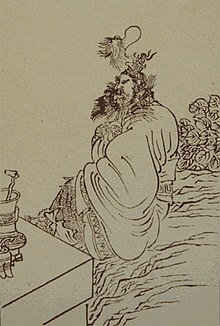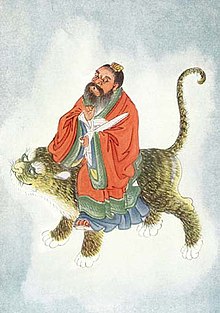| Zhang Daoling | |
|---|---|
 Zhang Daoling, as illustrated by Ren Xiong and engraved by Cai Zhaochu Zhang Daoling, as illustrated by Ren Xiong and engraved by Cai Zhaochu | |
| Born | 22 February 34 (traditionally) |
| Died | 10 October 156 (traditionally) (aged 121–122?) Mount Qingcheng, Han |
| Occupation | Religious leader |
| Known for | Founder of Way of the Five Pecks of Rice |
Zhang Ling (simplified Chinese: 张陵; traditional Chinese: 張陵; pinyin: Zhāng Líng; Wade–Giles: Chang Ling; traditionally 22 February 34–10 October 156), courtesy name Fuhan (simplified Chinese: 辅汉; traditional Chinese: 輔漢), was a Chinese religious leader who lived during the Eastern Han dynasty credited with founding the Way of the Celestial Masters sect of Taoism, which is also known as the Way of the Five Pecks of Rice, and he is credited as being the founder of Taoism in legend. He is also the grandfather of the warlord Zhang Lu.
He is also known as Zhang Daoling (张道陵; 張道陵; Zhāng Dàolíng; Chang Tao-ling), Celestial Master Zhang (張天師, Zhāng tiānshī), Ancestral Celestial Master (祖天師, Zǔtiānshī) or Zhengyi Zhenren (正一真人) to Taoists. Zhang is sometimes pictured riding on a tiger. In some Taoist sects, Zhang, along with Ge Xuan, Xu Xun (许逊) and Sa Shoujian (萨守坚), are called the "Four Celestial Masters" (四大天師).
Biography
| Part of a series on |
| Taoism |
|---|
 |
| Concepts |
| Practices |
| Texts |
| Theology |
People
|
Schools
|
| Sacred places |
| Institutions and organizations |

The details of the life of the historical figure Zhang Ling are obscure; most of the information about him comes from later scripture and hagiography. According to these, Zhang traced his ancestral home to Feng County, Jiangsu, and was said to be a descendant of Zhang Liang. He was born in the tenth year of the Jianwu era during the reign of Emperor Guangwu of Han. He started reading the Tao Te Ching at a young age and studied in the Taixue (Imperial Academy) before. He served as a magistrate in Jiangzhou, Ba Commandery (present-day Chongqing) during the reign of Emperor Ming of Han.
Zhang later retired and led a reclusive life at Mount Beimang, where he practiced taoist methods of achieving longevity. When invited to serve as a boshi (equivalent of a present-day professor) in the Imperial Academy, he claimed that he was ill. Emperor He of Han summoned him thrice to serve as the Taifu (Imperial Tutor) but he refused again.
According to hagiographies compiled in approximately 400 C.E., in 142 C.E. the deity Taishang Laojun (a deified Laozi) revealed to Zhang on Mount Heming the "Doctrine of the Orthodox One the Authority of the Alliance" (pinyin: zhengyi mengwei dao), and bestowed upon him the title Celestial Master. The deity warned that plagues, beasts, and the demons of the Three Offices and Six Heavens of the underworld were due to be released upon humankind, and that only 240,000 people would be chosen as survivors and "seed people" (pinyin: zhongmin) to populate the new age, the era of Great Peace.
Zhang then endeavored to reform supposedly degenerate religious practices. After gathering numerous followers, he started a health cult that advocated certain longevity practices, recorded in books which have been lost. He founded a theocratic state in Sichuan organized into 24 parishes, later 28, which outsiders called the Way of Five Pecks of Rice, after a tax of that amount levied on followers.
A major change instituted by the new Covenant was the rejection of food and animal sacrifices. According to Zhang, the updated teachings of Laozi included the first true Taoist religious pantheon as distinguished from the prior ancient religion of China. The Xiang'er, a commentary on the Tao Te Ching preserved today in a sixth-century manuscript, is traditionally ascribed to Zhang Daoling's authorship and even if not his work may reflect his teachings.
Zhang is said to have died on Mount Qingcheng in 156 during the reign of Emperor Huan of Han at the purported age of 123. However, it is also said that Zhang did not die but learned the arcana of Taoism to ascend in broad daylight (Xiandao). Zhang reportedly disappeared on the day of his death, leaving nothing behind but his clothes.
Descendants
His descendants have held the title of Celestial Masters up to the present day, with the most recent claimants of the title currently residing in Mainland China and Taiwan. They also held the title of 正一嗣教眞人 zhèng yī sìjiào zhēnrén.
See also
Notes
- In this Chinese name, the family name is Zhang.
- 瞿海源 (30 April 1992). 《重修臺灣省通志‧卷三‧住民志‧宗教篇(第一冊)》 (in Chinese). Republic of China: Taiwan Historica. pp. 40-41. ISBN 9789570007381.
正乙派開祖。據臺灣道士所傳「道教源流」云:漢天師諱道陵,字漢輔,沛豐邑人,留侯子房八代嫡孫大順之長子。光武建武十年正月望日生,七歲讀道德經,五千言二篇,十遍而達其旨。永和四年生辰,獲丹書秘訣,遂於鶴鳴山修煉。漢安元年壬午正月望日午時,感金闕后聖玄元道君,即老君下降,以盟成法篆,三五斬邪劍,都功板卷鑲授之。遂能服丹載魁罡,立治庭。而後太上授傳「三清眾經九百三十六卷,符錄丹霞秘訣七十二卷,並製頂冠道服等物賜之,。至桓帝永壽年間,屢賜此經並五斗真經。至永泰二年丙申九月九日,居間州雲臺山,忽太上遣使授此經玉册賜之三天扶教輔元大法天師正一靜應顯祐真君之號。
- "8th July, 2020: 張道陵 Zhang Dao Ling – Purple Cloud". Retrieved 2020-10-08.
- ^ Robinet, Isabelle. "Zhang Daoling". in Jones, Lindsay ed. Encyclopedia of Religion. 2nd ed. Detroit: Macmillan Reference USA, 2005. p. 9954.
- Greg Woolf (2007). Ancient civilizations: the illustrated guide to belief, mythology, and art. Barnes & Noble. p. 218. ISBN 978-1-4351-0121-0.
- Kohn, Livia. Daoism Handbook. Leiden: Brill, 2000. pp. 264–266.
- Bokenkamp, Stephen R. Early Daoist Scriptures. Berkeley: University of California Press, 1997. pp.29–148. (includes full, annotated translation of the text)
- Meyer, Milton Walter (1997). Asia: a concise history. Rowman & Littlefield. p. 90. ISBN 0847680681. OCLC 33276519.
- Brunnert, Ippolit Semenovich; V. V, Hagelstrom; Kolesov, Nikolai Fedorovich; Bielchenko, Andrei Terentevich; Moran, Edward Eugene (1911). Present Day Political Organization of China. Routledge. pp. 494–495. ISBN 978-1-135-79795-9 – via Internet Archive.